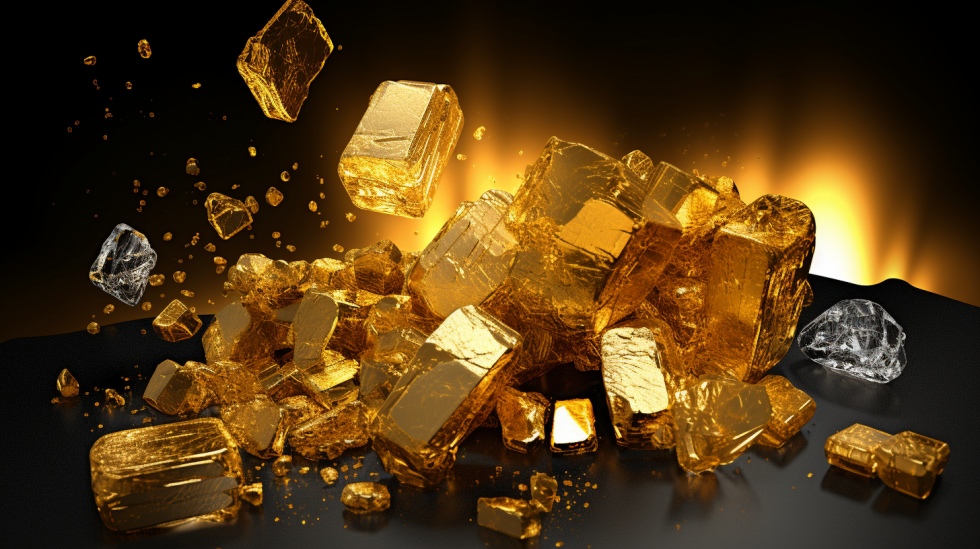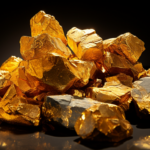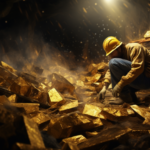Gold, with its radiant beauty and enduring value, has captured the human imagination for millennia. But how did this precious metal come to be? The formation of gold is a tale of cosmic events, elemental alchemy, and geological processes that unfolded over billions of years. In this exploration of gold’s origin, we will journey from the depths of supernova explosions to the Earth’s crust, uncovering the remarkable story of how gold was forged in the heart of the universe and delivered to our planet.

The Cosmic Crucible: Supernovae Nucleosynthesis
The story of gold begins in the cataclysmic explosions of massive stars known as supernovae. These extraordinary events are the cosmic crucibles where elements are born through a process called nucleosynthesis.
Stellar Nucleosynthesis
Inside massive stars, like those with at least eight times the mass of our sun, immense heat and pressure create an environment where atoms are fused together. In the fiery core of these stars, hydrogen atoms fuse to form helium, and this process continues through a series of nuclear reactions, creating heavier and heavier elements.
The Birth of Elements
The life cycle of a massive star culminates in a dramatic supernova explosion. During this explosive event, the star releases an incredible amount of energy, equivalent to the light of billions of stars. In the intense heat and pressure of a supernova, elements up to iron on the periodic table are synthesized. However, elements heavier than iron, including gold, require even more extreme conditions to form.
The R-Process
Gold is primarily formed through a specific type of nucleosynthesis called the rapid neutron capture process, or the “r-process.” In the moments leading up to and during a supernova explosion, a flood of neutrons inundates atomic nuclei. These neutrons are rapidly captured by existing nuclei, causing them to become unstable and decay. This process of neutron capture and decay happens so quickly that it outpaces the ability of protons to repel each other, leading to the formation of heavy elements like gold.
Galactic Alchemy: The Dispersion of Heavy Elements
After a supernova explosion, the newly synthesized heavy elements, including gold, are ejected into space in a dazzling display of cosmic fireworks. These elements are dispersed as part of the interstellar medium, which is a mixture of gas and dust that fills the vast expanse of galaxies.
Stellar Winds and Shockwaves
The remnants of a supernova explosion continue to evolve, creating shockwaves and stellar winds that propel heavy elements into space. These expelled elements mix with the surrounding interstellar medium, enriching it with a smorgasbord of elements, including gold.
Star Formation
Within the enriched interstellar medium, new generations of stars are born. These stars incorporate the heavy elements from supernova remnants into their composition, including gold. Over billions of years, multiple cycles of star formation, supernova explosions, and element dispersion contribute to the gradual accumulation of heavy elements in galaxies.
The Solar System’s Birthright: Gold on Earth
Our solar system, including Earth, was formed from the remnants of previous generations of stars. As the sun and planets coalesced from the dusty, gas-rich disk of matter surrounding a young star, they inherited a legacy of heavy elements, including gold.
Planetesimal Formation
Within the swirling disk of dust and gas around the young sun, planetesimals—small, rocky bodies—began to form. These planetesimals served as the building blocks for planets.
Gold’s Arrival on Earth
Gold, along with other heavy elements, was present in the material that made up Earth. As the planetesimal collisions and accretion continued, these heavy elements became incorporated into the nascent Earth.
Earth’s Differentiated Core
During the early stages of Earth’s formation, the planet underwent a process of differentiation, where heavier elements like iron sank to the core, while lighter elements rose to the surface. Gold, being relatively inert and not prone to bonding with other elements, tended to remain in the Earth’s crust and mantle rather than sinking to the core.
Geological Alchemy: Concentrating Gold Deposits
While gold exists in trace amounts throughout Earth’s crust, it is typically not found in significant concentrations. The formation of economically viable gold deposits requires additional geological processes that concentrate the metal into mineable ores.
Hydrothermal Processes
One of the primary mechanisms for gold concentration is hydrothermal processes. These occur when hot, mineral-rich fluids rise from the Earth’s mantle into the crust. As these fluids circulate through cracks and fissures in rocks, they can dissolve and transport gold and other valuable minerals.
Vein Formation
As hydrothermal fluids cool, they lose their capacity to hold dissolved minerals, leading to the precipitation of gold and other minerals in veins. Over time, these veins can become sources of concentrated gold deposits.
Placer Deposits
Placer deposits are another common form of gold concentration. They are created when gold, eroded from its original source by weathering and erosion, is transported by rivers and streams and deposited in alluvial sediments. Over time, these deposits can accumulate and be mined through methods like panning and dredging.
Geological Events
Tectonic and geological events, such as the movement of tectonic plates, faulting, and mountain-building processes, can play a crucial role in concentrating gold deposits. These processes can create the conditions necessary for the formation of gold-bearing rocks and ores.
The Modern Gold Rush: Mining and Extraction
Once economically viable gold deposits are identified, the process of mining and extracting gold begins. This process involves a combination of geological surveys, drilling, extraction methods, and refining.
Exploration and Drilling
- Geological Surveys: Geologists use a variety of techniques, including geological mapping, geochemical analysis, and geophysical surveys, to identify areas with potential gold deposits.
- Exploratory Drilling: Core drilling and other exploratory techniques are used to sample subsurface rock and confirm the presence of gold-bearing ores.
Mining Methods
- Open-Pit Mining: This method involves removing overburden (soil, rock, and waste material) to expose gold-bearing ore near the surface. It is suitable for shallow deposits.
- Underground Mining: For deeper deposits, underground mining methods, such as shafts, tunnels, and adits, are used to access and extract gold-bearing ore.
Ore Processing
- Crushing and Grinding: Mined ore is crushed and ground into fine particles to expose the gold.
- Gravity Separation: Gravity methods, such as sluicing, shaking tables, and centrifugal concentrators, are used to separate gold from lighter materials.
- Chemical Extraction: Gold can be extracted from ore using chemical methods, including cyanidation, which involves the use of a weak cyanide solution to dissolve and recover gold from crushed ore.
- Flotation: In flotation, chemicals are used to selectively separate gold from other minerals and impurities.
Refining
After the gold is extracted, it may go through a refining process to further purify and prepare it for various applications. The refining process typically involves:
- Smelting: Gold is melted at high temperatures to separate impurities and create a more concentrated gold product.
- Electrowinning: In electrowinning, an electric current is passed through a gold solution to deposit pure gold onto electrodes.
- Chemical Refining: Chemical processes, such as the Miller process or the Wohlwill process, are used to further refine gold to its highest purity.
Environmental Considerations
Gold mining and extraction can have significant environmental impacts. Responsible mining practices seek to mitigate these impacts through measures such as reclamation and environmental monitoring. Sustainable mining practices aim to minimize habitat disruption, water pollution, and land disturbance.
Gold Beyond the Earth: Meteorite Gold
While most of Earth’s gold has a terrestrial origin, a small fraction of the precious metal arrived on our planet through meteorite impacts. Meteorite gold is chemically identical to Earth-bound gold and is found in impact craters and the fragments of meteorites.
Cosmic Gold
Meteorites, remnants of ancient celestial bodies, contain trace amounts of gold that were forged in the same cosmic crucibles as terrestrial gold. When a meteorite impacts Earth, it can release these tiny gold particles into the environment.
Impact Craters
Gold associated with meteorite impacts can be found in and around impact craters. The extreme heat and pressure generated during an impact can cause the vaporization and re-condensation of gold, leading to the formation of unique gold-bearing minerals.
Geological Significance
Studying meteorite gold can provide valuable insights into the conditions and processes that occur during high-energy cosmic events. It also offers a glimpse into the complex interactions between celestial bodies and our planet.
Conclusion: Gold’s Cosmic Odyssey
The formation of gold is a remarkable journey that begins in the fiery hearts of massive stars and continues through the crucibles of supernovae explosions. These cosmic alchemy processes create heavy elements, including gold, which are then dispersed into the universe.
The arrival of gold on Earth, as part of the planet’s formation and through meteorite impacts, adds to the intrigue of this precious metal’s origin. Geological processes further concentrate gold into mineable deposits, setting the stage for the modern gold rush.
As we contemplate gold’s cosmic odyssey, we gain a deeper appreciation for its rarity and enduring allure. Whether admired for its beauty, cherished as a store of value, or harnessed for its industrial applications, gold’s journey from the heart of the universe to the Earth’s surface is a testament to the remarkable processes that shape our world and the cosmos beyond.



